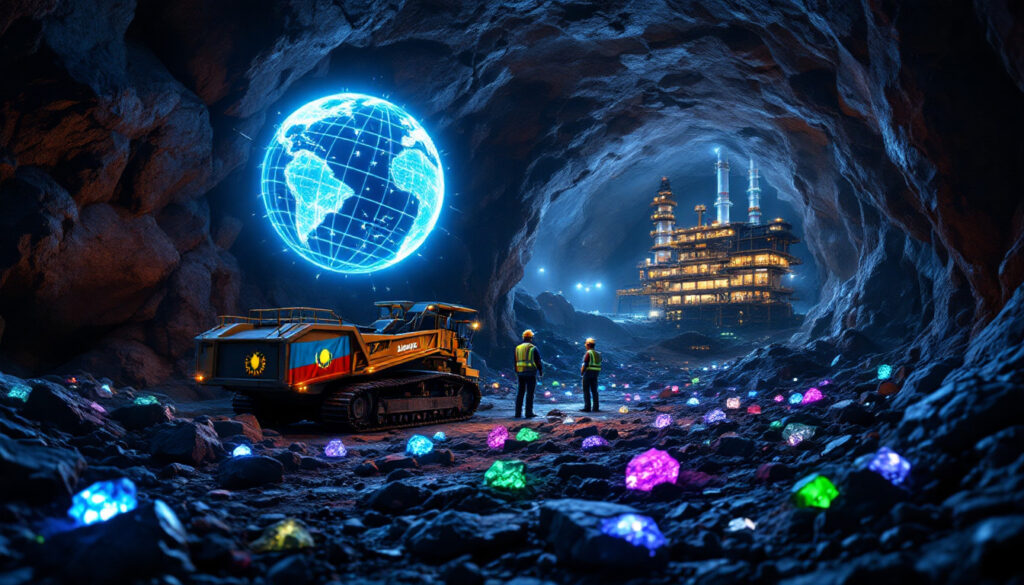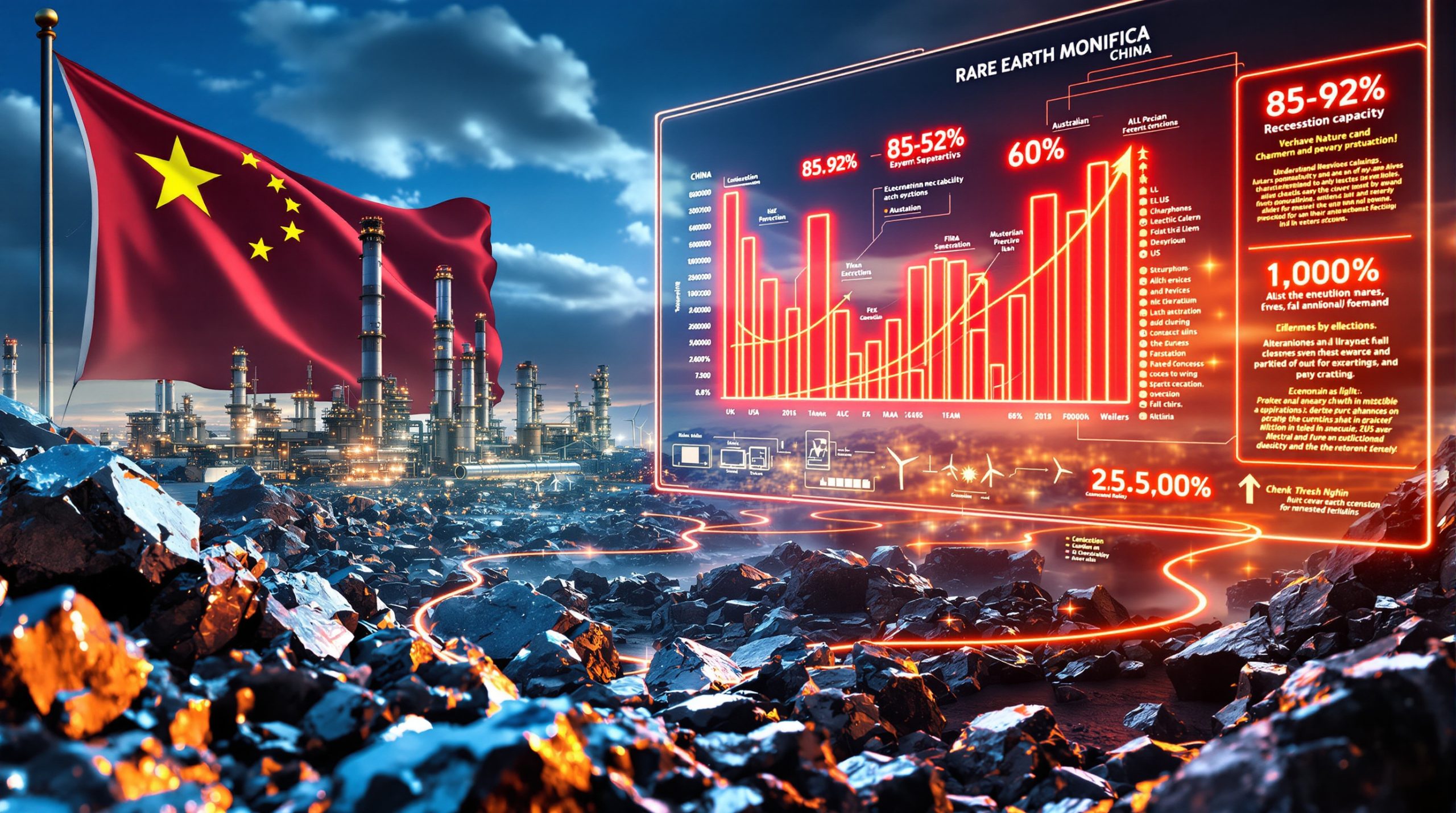What is Kazakhstan's New Rare Earth Metals Discovery?
A groundbreaking discovery of rare earth metals in Kazakhstan has recently made headlines, potentially reshaping the global rare earth elements (REE) landscape. The newly found deposit contains an estimated 20 million metric tons of rare earth metals, located at the Zhana Kazakhstan site approximately 420 km (261 miles) from the country's capital, Astana.
The deposit lies at depths of up to 300 meters, requiring sophisticated extraction techniques beyond typical open-pit mining methods used in shallower deposits. According to geological surveys, the site contains several commercially valuable elements including neodymium, cerium, lanthanum, and yttrium – all crucial components in modern technology manufacturing.
With an average rare earth metal content of 700 grams per ton, the Zhana Kazakhstan deposit shows higher concentration than China's famous Bayan Obo mine (500 g/ton), though less concentrated than Brazil's Pitinga deposits (approximately 1,200 g/ton). This places the deposit in a competitive middle range for commercially viable extraction.
Discovery Details and Location
The Kazakh Ministry of Industry and Infrastructure Development announced this significant find following extensive geological surveys. The remote location, while challenging from an infrastructure perspective, offers Kazakhstan strategic advantages as the country seeks to diversify its mineral exports beyond traditional oil and uranium resources.
"This deposit represents a turning point for Kazakhstan's mining sector," noted industry analyst Mariya Gordeyeva. "However, third-party verification of these reserves will be crucial for establishing international confidence in the discovery's scale."
The Zhana Kazakhstan site's geological formation appears to be primarily carbonatite-based, suggesting specific extraction and processing requirements that differ from ion-adsorption clay deposits common in southern China and Southeast Asia.
Geological Significance
If independent audits confirm the reported 20 million metric tons of rare earth elements, Kazakhstan would vault into position as the world's third-largest holder of rare earth reserves, behind only China (approximately 44 million tons) and Brazil (21 million tons).
Notably, Kazakhstan currently doesn't feature in the U.S. Geological Survey's official list of countries with significant rare earth metal deposits. A USGS representative commented that "Kazakhstan's absence from our reserve list reflects outdated data, not necessarily actual geological capacity."
This discovery represents one of the largest rare earth findings in recent decades, potentially adding approximately 5% to global known reserves. The deposit's composition includes both light rare earth elements (LREEs) like cerium and lanthanum, plus more valuable heavy rare earths including yttrium, enhancing its economic significance.
How Does This Discovery Impact Global Rare Earth Supply?
The Kazakhstan rare earth metals deposit comes at a crucial moment in global rare earth supply dynamics, potentially offering an alternative to China's market dominance and addressing Western concerns about supply chain security.
Current Global Rare Earth Market Structure
China currently dominates the global rare earth industry, controlling approximately 70% of worldwide mining and a commanding 90% of processing capacity according to 2024 data from the Center for Strategic and International Studies (CSIS). Western nations, particularly those with advanced manufacturing sectors, remain approximately 80% reliant on Chinese rare earth imports according to EU Critical Raw Materials Act assessments.
Brazil possesses significant reserves but has struggled to develop large-scale production and processing capabilities. Other nations with notable deposits include Vietnam, Australia, and the United States, though none currently challenge China's market position.
Western nations have actively pursued supply diversification strategies since China's 2010 export restrictions highlighted supply chain vulnerabilities. The MP Materials' Mountain Pass mine revival in California exemplifies these efforts, though even this operation must ship concentrates to China for processing due to gaps in domestic capabilities.
Kazakhstan's Potential Position in Global Markets
Kazakhstan's emergence as potentially the third-largest holder of rare earth reserves globally creates strategic opportunities for the Central Asian nation. While reserve size is significant, developing competitive production capacity requires substantial investment in extraction, separation, and processing infrastructure.
Industry estimates suggest Kazakhstan would need more than $3 billion in processing infrastructure investments to bypass China's processing monopoly, according to the Rare Earth Industry Association. Without domestic processing capabilities, Kazakhstan might face the same challenges as other producers – mining materials only to ship them to China for value-added processing.
The proposed EU-Kazakhstan Critical Minerals Pact, targeted for ratification by 2026, could accelerate development by providing technical expertise and market access. This partnership model could help Kazakhstan avoid the development challenges faced by Vietnam's stalled Dong Pao rare earth project.
Supply Chain Implications
Kazakhstan's entry as a major rare earth supplier could significantly reduce global dependency on Chinese rare earth elements. This diversification would address growing concerns in Europe, North America, and Japan about supply vulnerabilities in critical mineral supply chains.
The deposit could particularly influence pricing and availability of neodymium and praseodymium (NdPr), key components in permanent magnets used in electric vehicles and wind turbines. With global demand for neodymium projected to increase 300% by 2030 compared to 2023 levels, new supply sources are essential to prevent severe shortages.
Additionally, Kazakhstan's central location creates opportunities for new trade relationships connecting Asian and European markets, potentially establishing the country as a mineral trade hub for Central Asia.
What Makes This Rare Earth Deposit Strategically Important?
Critical Minerals for Modern Technology
The elements discovered at the Zhana Kazakhstan site represent the building blocks of numerous technologies essential to the green energy transition and advanced manufacturing:
Neodymium stands as perhaps the most commercially significant find, serving as a critical component in creating powerful permanent magnets used in electric vehicle motors (requiring approximately 2kg per vehicle) and wind turbine generators. With EV production expected to triple by 2030, securing neodymium supplies has become a priority for automotive manufacturers.
Cerium, while less valuable per kilogram than neodymium, remains essential for catalytic converters, precision glass polishing, and as a catalyst in petroleum refining and chemical production. Its widespread use creates stable demand across multiple industries.
Lanthanum plays a crucial role in hybrid car batteries (particularly nickel-metal hydride designs), specialized glass for camera lenses, and as a catalyst in petroleum refining. Toyota's production of hybrid vehicles alone consumes significant quantities of lanthanum annually.
Yttrium, commanding approximately $540/kg in projected 2025 spot prices, serves specialized applications including LED phosphors, ceramic strengthening for industrial applications, and advanced coatings for hypersonic missile systems.
Geopolitical Significance
The discovery holds substantial geopolitical implications beyond its economic value. Western nations' growing concerns about rare earth supply security have intensified amid U.S.-China trade tensions and China's 2024 export controls on cerium and lanthanum compounds.
The U.S. Defense Logistics Agency has established stockpile targets of 1,000 tons of NdFeB (neodymium-iron-boron) magnets by 2027, highlighting the military significance of these materials. Kazakhstan's emergence as an alternative supplier creates strategic opportunities for new international partnerships.
For Kazakhstan itself, rare earth resources provide diplomatic leverage and opportunities to strengthen ties with both Asian and European partners. The country's positioning between major technology manufacturing centers creates natural market advantages if properly developed.
Economic Impact for Kazakhstan
Beyond immediate mineral revenues, this discovery offers Kazakhstan opportunities to diversify its economy beyond traditional oil and uranium exports. The country's GDP currently depends heavily on fossil fuel exports, creating vulnerability to price fluctuations.
Developing downstream processing and manufacturing capabilities could exponentially increase the economic benefits compared to raw material exports alone. Each step in the value chain – from mining to oxide production to metal manufacturing to component creation – multiplies the economic value captured domestically.
The discovery also positions Kazakhstan to attract foreign investment in mining technology, processing facilities, and supporting infrastructure. Experience from Kazakhstan's uranium sector, where the country has successfully developed world-leading production capabilities, suggests potential for similar development in rare earths.
What Challenges Might Affect Development of the Deposit?
Technical and Operational Considerations
The Zhana Kazakhstan deposit presents significant technical challenges beginning with its depth. At up to 300 meters underground, extraction requires sophisticated shaft mining techniques rather than more economical open-pit methods. This increases capital costs and operational complexity compared to shallower deposits.
Infrastructure limitations pose additional hurdles. The nearest railhead lies approximately 82km away, requiring construction of a new spur line at an estimated cost of $2 million per kilometer. Water availability also presents concerns, with the region receiving less than 500mm annual rainfall compared to the 800mm typically needed for solvent extraction processes.
Processing requirements for the specific rare earth composition found at Zhana Kazakhstan will necessitate customized separation facilities. Rare earth processing typically involves complex, multi-stage chemical separation to isolate individual elements from mixed concentrates.
Environmental Concerns
Rare earth mining and processing carries significant ESG challenges that must be addressed in development planning. Processing typically generates substantial volumes of acidic wastewater requiring treatment before discharge.
The potential presence of naturally occurring radioactive materials (NORM) like thorium and uranium in rare earth deposits requires specialized handling protocols. Radiation levels at similar processing facilities, such as Lynas' Malaysian plant, have registered at approximately 5μSv/hr compared to natural background levels of 0.5μSv/hr.
Chemical consumption in rare earth processing is substantial, typically requiring 4-6 tons of hydrochloric acid per ton of rare earth oxide produced. Sourcing these chemicals and managing waste streams requires comprehensive environmental planning and monitoring systems conforming to ISO 14001 certification standards.
Investment and Development Timeline
No information has been provided regarding which companies may develop the site or potential timelines for production. International mining projects of this scale typically require 5-10 years from discovery to commercial production, with significant capital investments throughout the development cycle.
The capital requirements for developing a deposit of this magnitude will likely exceed $1 billion for mining infrastructure alone, with processing facilities potentially doubling this investment. Kazakhstan may need to partner with international mining companies or seek foreign investment to fully develop the resource.
Processing cost benchmarks suggest Kazakhstan would face production costs of $8-12 per kilogram of rare earth oxide compared to China's approximately $6 per kilogram, creating challenges for international competitiveness without additional advantages in quality or supply security.
How Does This Compare to Other Major Rare Earth Deposits?
Global Rare Earth Reserves Comparison
China maintains its position as the world's largest rare earth holder with approximately 44 million tons of reserves and dominant production capacity across both light and heavy rare earth elements. The country's Bayan Obo mine in Inner Mongolia has operated since 1957 and remains the world's largest single rare earth production center.
Brazil holds second place with approximately 21 million tons of reserves but has struggled to develop large-scale production facilities. The country's Pitinga deposits show high concentration levels but face challenges in infrastructure development and processing technology.
Kazakhstan's 20 million ton deposit, if confirmed, would secure third position globally. Other significant deposits include Vietnam's Dong Pao project (estimated 11 million tons), Russia's Tomtor deposit (approximately 10 million tons), and Australia's various projects totaling around 4 million tons collectively.
Concentration and Quality Factors
The average rare earth content of 700 grams per ton at the Kazakhstan site places it in a commercially viable range, though not exceptional by global standards. For comparison:
| Deposit | RE Content | Heavy RE% | Development Stage |
|---|---|---|---|
| Bayan Obo (China) | 500 g/t | 15% | Active since 1957 |
| Pitinga (Brazil) | 1200 g/t | 8% | Pre-feasibility |
| Zhana (Kazakhstan) | 700 g/t | 12% | Resource Estimate |
The deposit's reported composition includes approximately 12% heavy rare earth elements, which typically command higher market prices than light rare earths. This composition compares favorably to many other deposits and contributes to the site's potential economic viability despite moderate overall concentration levels.
What Are the Investment Implications?
Mining Development Opportunities
The Zhana Kazakhstan deposit presents significant opportunities for international mining companies seeking to diversify rare earth supply sources. Joint venture structures with Kazakhstan's national mining entities offer potentially attractive frameworks for development, leveraging local expertise and international technology.
Kazakhstan's existing mining sector, particularly its world-leading uranium production, demonstrates the country's capacity to develop sophisticated extraction industries. The country's 12,000 trained geologists (compared to Australia's approximately 28,000) provide a foundation for technical development, though specialized rare earth expertise may require international recruitment similar to Rio Tinto's rare earth talent acquisition efforts in Mongolia.
Infrastructure investment requirements extend beyond the mine site itself to transportation networks, processing facilities, and supporting utilities. These development needs create opportunities for construction firms, equipment suppliers, and engineering companies specializing in mining infrastructure.
Market Impact on Rare Earth Prices
While the discovery has potential long-term implications for global rare earth pricing, immediate market impact remains limited pending development timelines. Rare earth prices have historically shown volatility, with the NdPr (neodymium-praseodymium) price experiencing multiple significant spikes over the past decade due to export restrictions and supply uncertainties.
The equity risk profile for developing the Kazakhstan deposit appears comparable to Greenland's Kvanefjeld project, which showed a net present value of approximately $1.4 billion at rare earth oxide prices of $30 per kilogram. However, actual returns depend heavily on processing recovery rates, capital costs, and market conditions at production time.
Strategic stockpiling considerations by major consuming nations, particularly Japan, South Korea, and European countries, could create early demand for Kazakh production as these countries seek to diversify supply away from Chinese dominance. The Australian government's $400M boost to Iluka's rare earth refinery demonstrates how governments are supporting domestic processing capabilities to reduce dependence on foreign refinement.
FAQ About Kazakhstan's Rare Earth Discovery
What rare earth elements were found in the Kazakhstan deposit?
The deposit contains neodymium, cerium, lanthanum, and yttrium, with an average rare earth metal content of 700 grams per ton. Neodymium represents the highest commercial value among these elements due to its essential role in permanent magnets for electric vehicles and wind turbines.
How does this discovery rank globally in terms of size?
If confirmed, this 20-million-ton deposit would make Kazakhstan the third-largest holder of rare earth reserves globally, behind only China (44 million tons) and Brazil (21 million tons). This represents approximately 5% of global rare earth reserves.
Has development of the deposit begun?
No information has been provided about which companies may develop the site or when development might begin. Typical rare earth projects require 5-10 years from discovery to commercial production, suggesting any output would likely be at least several years away.
What are the potential uses for the rare earth elements found?
The discovered elements are critical for technologies including permanent magnets (neodymium), catalytic converters (cerium), hybrid car batteries (lanthanum), and LEDs and ceramics (yttrium). These applications span renewable energy, automotive, electronics, and defense industries, making them strategically important for modern manufacturing.
Furthermore, this development comes at a time when many nations are navigating the critical minerals race amid growing resource nationalism and geopolitical tensions. For investors interested in this sector, understanding the various factors influencing mineral development projects is crucial for navigating mining investments successfully in today's complex global environment.
Want to Discover High-Potential ASX Mining Opportunities Before the Market Does?
Stay ahead of the curve with Discovery Alert's proprietary Discovery IQ model, which instantly identifies significant mineral discoveries like Kazakhstan's rare earth find as they're announced on the ASX. Explore why major discoveries can lead to exceptional returns by visiting Discovery Alert's discoveries page.




